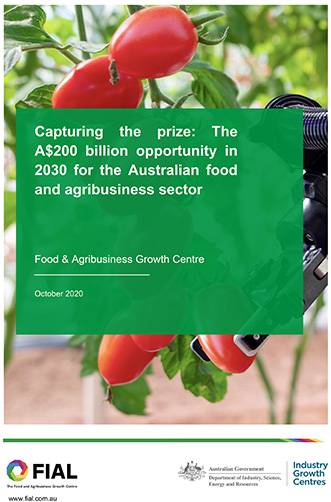The Australian Institute of Packaging is pleased to have contributed to a report ‘Capturing the Prize’, which was commissioned by the Food and Agribusiness Growth Centre, FIAL.
This landmark report reveals that by 2030, the Australian food and agribusiness sector could be contributing in excess of $200B to annual GDP. This is three times greater than its current value add of $61B.
 The report takes into account the 10 Future Trends and identifies 19 Growth Opportunities that – if pursued – will unlock the sector’s untapped potential of over $200 Billion within the decade.
The report takes into account the 10 Future Trends and identifies 19 Growth Opportunities that – if pursued – will unlock the sector’s untapped potential of over $200 Billion within the decade.
The AIP established the Sustainable Packaging Working Advisory Group for the Growth Opportunities and developed the recommended project outline for the 2030 roadmap.
The changing food and agribusiness sector
10 trends, ranging from growth in the consuming class, through to increasing concerns with food security following COVID-19 will radically change the food and agribusiness sector over the next decade. The food and agribusiness sector refers to opportunities in the agriculture, fishing and food-related manufacturing value chain, including agricultural machinery, seeds and packaged food products. A range of socioeconomic, geopolitical, technological, and consumer trends are converging to rapidly change the food and agribusiness landscape. These include urbanisation helping to create a growing pool of new consumer markets, particularly in middleweight cities (defined as cities with populations of between one to five million) in Asia, through to increasing supply chain connectivity (linked in part to the Belt and Road Initiative) and shifting consumer tastes linked to health and environmental concerns.
The value opportunity
From superfood to urban farming – Australia’s food and agribusiness sector is facing exciting new opportunities to reach consumers and lead a global race for innovation. The 19 most promising growth ideas could be worth over A$200 billion by 2030.
Growing tomorrow’s food requires a mindset shift. Many traditional ways of producing crops and breeding livestock are challenged by environmental and societal changes, in Australia and globally. Soils are degrading, consumer tastes are evolving, and rising wealth is fuelling Asia’s demand for meat. At the same time, these challenges present a substantial opportunity for the Australian food and agribusiness sector. FIAL research has identified 19 areas worth exploring for Australian businesses willing to take the lead in unlocking new markets (Exhibit E1). They range from new opportunities to satisfy a growing appetite for healthy foods, to developing biodegradable packaging and technology to reduce food waste as well as increasing crop yields using robotics and internet-controlled sensors on farms.
• The opportunity is growing:
Together, these opportunities could be worth over A$200 billion by 2030 (in terms of value added). To put this in perspective, this is almost triple the current value of Australia’s food and agribusiness sector (which was A$67.2 billion in 2017-18 and A$61.3 billion in 2018-19)5
• Feeding future consumers:
The largest value opportunity for firms in the Australian food and agribusiness will revolve around servicing a new generation of consumers (the future consumer). Opportunities in the health and wellness category cater to a rising number of health-conscious people favouring unprocessed, organic and ‘free from’ foods in Australia and globally could amount to roughly A$45 billion in 2030. Growing demand for traditional proteins (meat, egg and dairy) could present an additional opportunity worth A$31 billion.
Click here to access the full report
.
.
